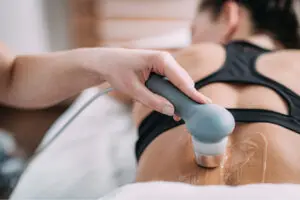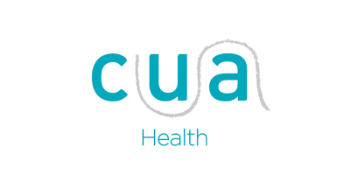If you are suffering from stiff neck joint pain, facet joints may be the issue. Facet joint pain is the result of issues at the facet joint. This can lead to joints feeling stiff and locking.
Book your Myotherapy Treatment
Facet Joint Syndrome essentially means pain in a spinal joint. Facet joints guide and limit movement of their respective vertebra.
There are two facet joints (left and right) in each vertebra.
You may hear them referred to by the region as the:
- cervical facet joints – neck
- the thoracic facet joints the upper and mid back
- lumbar facet joints – the low back
Facet joint pain is a common cause of neck pain (wry neck link), back pain and thoracic spine pain.
What Causes Stiff neck Joint Pain?
Acute injury is the common cause of Facet joint dysfunction in the under 40’s. Joint motion can stiffen (through degenerative diseases such as arthritis) – which is known as hypomobility. Conversely, joint motion can become excessive (usually due to lax ligaments) – known as hypermobility.
What Causes Facet Joint Hypomobility?
Loss of joint motion or joint hypomobility is caused by:
- arthritis within the facet joint
- bone spurs – also known as facet joint osteophytes
- joint capsule thickening or scarring
- muscle spasm
- a locked facet joint (in the neck this is known as wry neck)
Facet joint degeneration or uncontrolled motion may lead to a loss of function
Muscle strength and endurance are fundamental to stabilise and control facet joints.
Book your Myotherapy Treatment
The Rusty Hinge analogy
The adage – motion is lotion is often true.
After injury and/or as a result of sedentary lifestyles – people often stop moving their neck (or other joints) through their full range of motion. When the joint stops moving to its full range – it becomes accustomed to being stiff and irritable – not unlike a rusty hinge. Motion is lotion – moving through full range promotes blood flow to all the joints and their parts – like the proverbial spray of WD-40. Consulting with a Myotherapist can help desensitize stiff neck joint pain and discomfort and help you feel comfortable and safe moving your neck again.
What Causes Facet Joint Hypermobility?
Hypermobility is usually caused by trauma:
- overstretched ligaments (in the neck a whiplash injury is very common)
- fracture
- dislocation
- a degenerative disease which reduces the surface area of the joint – such as Rheumatoid arthritis
What Causes a Locked Facet Joint?
When an unexpected movement exceeds your muscles ability to control the joint you move into a position that the joint is not meant to traverse – the joint may lock out of place then.
Previous Facet injuries – especially if they have not been professionally rehabilitated or rehabilitated incompletely – increase the likelihood of repeating the lock.
What are the Symptoms of a Locked Facet Joint?
Pain is an alarm system – telling the body that something is wrong. It is usually the first obvious symptom after a facet joint injury.
A neck facet joint will cause local pain in the neck and may refer into the shoulder and arm.
A facet injury in the back will usually create low back pain and may refer into the glute and down the leg.
A locked facet joint usually stops movement in the opposite direction.
For example – if a neck joint is locked on the left – it will be difficult and painful to rotate over the right.
Muscle spasm is the body’s way of protecting the locked joint – a Myotherapist will always try to unlock the joint before removing spasm.
Facet injuries are usually acute – but can happen days or weeks before the locking and spasm present.
The body will compensate for the loss of motion through the locked joint by allowing nearby joints to move excessively. This hypermobility will often lead to more problems.
People who experience this problem regularly are diagnosed with facet joint syndrome. Facet joint syndrome is usually a result of weak underperforming stabilisers (muscles).
Break Free from the Grip of Stiff Neck Joint Pain!
How is a Facet Joint Injury Diagnosed?
Myotherapists are skilled at detecting and freeing the locked joint level.
Facet Joint Syndrome Treatment
Unlocking the joint is usually not a difficult prospect.
Corrective exercise is the best way to reduce and eliminate the problem. Your Myotherapist will design a program that is designed to improve the muscles and structures that require more durability.
Unstable Facet Joint Treatment
Hypermobile joints require a corrective exercise program to increase stability.
How do I reduce pain in the painful neck joint after it is unlocked?
Protective muscle spasm may linger after the joint has been unlocked. Manual techniques such as Massage and Dry Needling are very effective at relieving this type of spasm. Laser – or Low Level Laser Therapy is an outstanding and pain free solution to muscle spasm and inflammation. LLLT promotes an accelerated healing response and has been recommended by the World Health Organisation in the treatment of chronic neck and back irritation.
Book your Myotherapy Treatment
World Health Organisation Bone and Joint Task Force Task Force support LLLT for neck pain
Results of the Bone and Joint Decade 2000-2010 Task Force on Neck Pain and Its Associated Disorders.
https://www.ncbi.nlm.nih.gov/pubmed?Db=pubmed&Cmd=DetailsSearch&Term=18204386%5Buid%5D
This paper also recommends Low Level Laser Therapy above many other modalities including anti-inflammatories
Related Posts

Wry Neck Brisbane

Low level laser therapy

Natural Pain Relief with Thermotherapy
https://www.ncbi.nlm.nih.gov/pubmed/20704667
https://www.ncbi.nlm.nih.gov/pubmed/15389743
http://medlouxx.com/Internet%20medlouxx%20de/files/downloads/R%20CHOW%20et%20al%20Pain%202006.pdf
https://abcnews.go.com/Health/CommonPainProblems/story?id=4047870
https://www.ncbi.nlm.nih.gov/pubmed?Db=pubmed&Cmd=DetailsSearch&Term=18204386%5Buid%5D
https://www.ncbi.nlm.nih.gov/pubmed/?term=28192789
https://www.health.harvard.edu/blog/treating-neck-pain-with-a-dose-of-exercise-201112123928

Roger Morelli


Latest posts by Roger Morelli (see all)
- Lymphatic Drainage Massage Benefits - October 18th, 2024
- Lymphatic Compression Pump Therapy Brisbane - October 16th, 2024
- Lymphoedema Brisbane - October 14th, 2024












